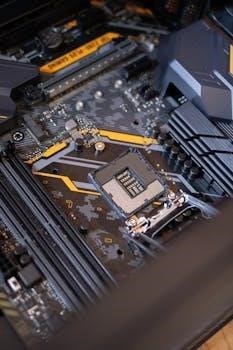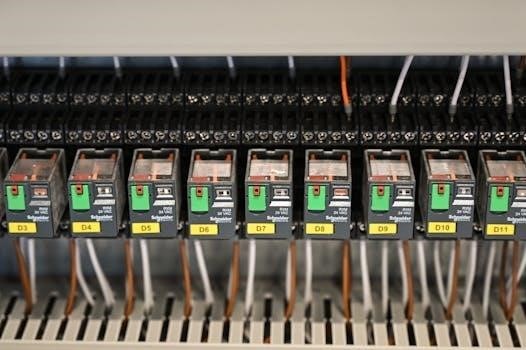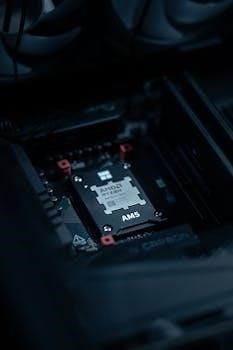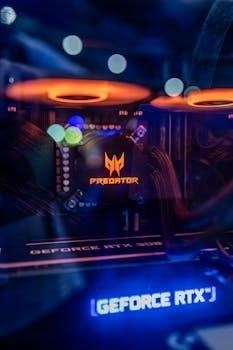This section introduces the power of MATLAB/Simulink for simulating power electronics circuits. It emphasizes its role in design, analysis, and prototyping. Learn how this tool enhances understanding and development.
Overview of MATLAB/Simulink for Power Electronics
MATLAB/Simulink provides a powerful environment for simulating power electronics systems. Its graphical interface allows for intuitive model building using pre-built blocks from libraries like Simscape Electrical. This enables engineers to quickly create and test complex circuits, including those with semiconductor devices, motors, and control systems. The software’s capabilities extend to analyzing system-level performance, making it an essential tool for both design and analysis. Furthermore, MATLAB’s ability to parameterize models using variables enhances flexibility and reusability. The integration of simulation with control system design makes MATLAB/Simulink a comprehensive platform for power electronics development. It facilitates the modeling of multidomain systems and determination of losses.
Benefits of Simulation in Power Electronics Design
Simulation using MATLAB/Simulink offers numerous advantages in power electronics design. It allows engineers to effectively test circuit designs before physical implementation, saving time and resources. Simulation enables the selection of suitable semiconductor components by analyzing waveforms, allowing for optimization of circuit performance. It facilitates the extraction of dynamic models of converters, which aids in the design of effective controllers. This process also helps in reducing component size and determining power losses efficiently. Through simulation, engineers can explore various scenarios and refine designs, leading to more robust and reliable power electronic systems. Furthermore, simulation allows for the analysis of complex system behavior, which can be difficult or impossible to achieve through analytical methods alone.

Fundamentals of Power Electronics Circuits
This section explores the basic building blocks of power electronics. It covers essential devices and common converter topologies, crucial for understanding circuit simulation and analysis.
Basic Power Semiconductor Devices and their Models
This section delves into the core components of power electronic circuits⁚ semiconductor devices. We will explore the characteristics and models of power diodes, silicon controlled rectifiers (SCRs), MOSFETs, IGBTs, and GTOs. Understanding these devices is crucial for accurate simulations. MATLAB/Simulink offers pre-built models for these devices, allowing users to quickly simulate their behavior within different circuits. The modeling includes parameters such as switching speeds, on-state resistance, and voltage drop. These models allow for comprehensive analysis of circuit performance. The section will explain how to choose suitable devices and configure models for simulation using MATLAB and Simulink. This is essential for ensuring realistic and reliable simulation results, which can then be used to improve designs and predict performance.
Common Power Electronic Converter Topologies
This section explores various essential power electronic converter topologies. These include AC-DC rectifiers, DC-DC converters (buck, boost, buck-boost), and DC-AC inverters. Understanding these topologies is vital for designing power electronic systems. We will examine the fundamental principles of operation for each topology. Specific emphasis will be placed on their application in different scenarios, such as power supplies, motor drives, and renewable energy systems. The section will cover the use of Simulink to build models of these converters, allowing for analysis of their performance. This includes examining waveforms, efficiency, and control strategies. We will discuss how to select the appropriate topology for a given application and how to optimize its design through simulation.

Modeling Power Electronic Systems in Simulink
This section focuses on using Simulink for modeling power electronic systems. It covers the practical aspects of building and parameterizing models for accurate simulations and analysis.
Using Simscape Electrical for Circuit Modeling
Simscape Electrical, a powerful tool within MATLAB/Simulink, offers a specialized environment for modeling electrical circuits, particularly in power electronics. It provides pre-built blocks representing various electrical components like diodes, MOSFETs, and IGBTs, allowing for the rapid construction of complex power electronic systems. Users can easily assemble circuits by dragging and dropping these blocks and connecting them using a graphical interface. Simscape Electrical also enables detailed modeling of the physical behavior of components, incorporating non-ideal effects and parasitic elements. This capability allows for more accurate simulations that closely reflect real-world behavior. Furthermore, it facilitates the modeling of multi-domain systems, where electrical components interact with mechanical and thermal components, providing a comprehensive view of system performance. The library is fully customizable, permitting users to create their own components, enabling the simulation of novel power electronic topologies.
Building and Parameterizing Models with MATLAB Variables
MATLAB’s capability to integrate with Simulink significantly enhances the flexibility and efficiency of power electronics modeling. By utilizing MATLAB variables, users can parameterize their Simulink models, making it easier to adjust component values and explore various design scenarios. Instead of manually entering values into each block, parameters can be defined as variables in the MATLAB workspace and linked to the corresponding blocks in Simulink. This approach centralizes parameter management and allows for quick modifications. Moreover, using MATLAB expressions, complex relationships between parameters can be established, simplifying sensitivity analyses and design optimization. This method fosters organized and reproducible simulations. It also allows for the use of scripts to create and modify Simulink models parametrically, thereby increasing the speed and automation of the simulation process. Overall, this integration is crucial for scalable and efficient power electronics design and analysis.

Simulation and Analysis Techniques
This section delves into techniques for effective simulation, covering parameter setup, and waveform analysis. Learn to extract performance metrics from simulations for thorough assessment of designs.
Setting up Simulation Parameters
Configuring simulation parameters in MATLAB/Simulink is crucial for obtaining accurate and meaningful results. This involves specifying the simulation time, solver type, and step size, which directly impact the simulation’s precision and computational load. It’s important to select appropriate parameters that reflect the dynamic behavior of the power electronic circuit being modeled. For instance, switched-mode power converters often require smaller step sizes to capture the rapid transitions of semiconductor devices. Furthermore, users can define initial conditions and tolerances to ensure stable and reliable simulation outcomes; The correct setup of these parameters is essential for efficient simulation and reliable analysis of the simulated circuit’s performance. Careful consideration of these settings is a prerequisite for achieving valid and informative simulations.
Analyzing Waveforms and Performance Metrics
Analyzing waveforms and performance metrics is vital for assessing the behavior of power electronic circuits simulated in MATLAB/Simulink. This involves examining voltage and current waveforms to identify critical parameters like switching frequency, ripple content, and transient response. Tools within Simulink allow for detailed visualization of these waveforms, aiding in identifying potential issues like overshoot or ringing. Performance metrics such as efficiency, total harmonic distortion (THD), and power factor can be calculated from the simulation data. These metrics provide quantitative measures of the circuit’s performance, enabling engineers to evaluate design choices. This analysis is crucial for verifying the functionality of the circuit and optimizing its operation for specific applications. It helps in making informed decisions for real world implementations.

Advanced Topics and Applications
Explore advanced control design for power converters and real-world applications. Discover case studies that demonstrate practical uses of power electronics simulations with MATLAB/Simulink.
Control System Design for Power Electronic Converters
Designing effective control systems for power electronic converters is crucial for achieving desired performance and stability. MATLAB/Simulink provides powerful tools for modeling and simulating these control systems. You can implement various control strategies, such as PID control, feedback loops, and more complex algorithms, within the Simulink environment. This allows you to analyze the dynamic behavior of the converter under different operating conditions and optimize the control parameters for efficient and reliable performance. The simulation environment enables testing and validation of the control designs before implementation on actual hardware. This process includes analyzing the closed loop response, assessing stability margins and evaluating disturbance rejection capabilities. This is done by utilizing MATLAB’s vast array of analytical capabilities in conjunction with Simulink’s modeling abilities, ensuring a robust design. Through this rigorous approach, engineers can confidently develop controllers that meet the specific requirements of their power electronic systems.
Real-World Applications and Case Studies
Power electronics simulation using MATLAB/Simulink finds extensive applications in numerous real-world scenarios. This includes analyzing and designing circuits for laptop chargers, motor control in washing machines, and electronic ballasts for lighting. Furthermore, the simulation extends to grid-level applications like AC to DC power conversion and renewable energy integration. Case studies often involve modeling complex systems, such as synchronous buck converters, and implementing controllers for optimized performance. By examining these real-world examples, you gain a comprehensive understanding of how simulation tools can be used for product development. These simulations provide valuable insights into component sizing, loss determination, and system behavior under different operational parameters. Students and engineers alike benefit from examining these cases to better understand practical design considerations. Simulation models developed in MATLAB and Simulink provide a base for further design and implementation.
